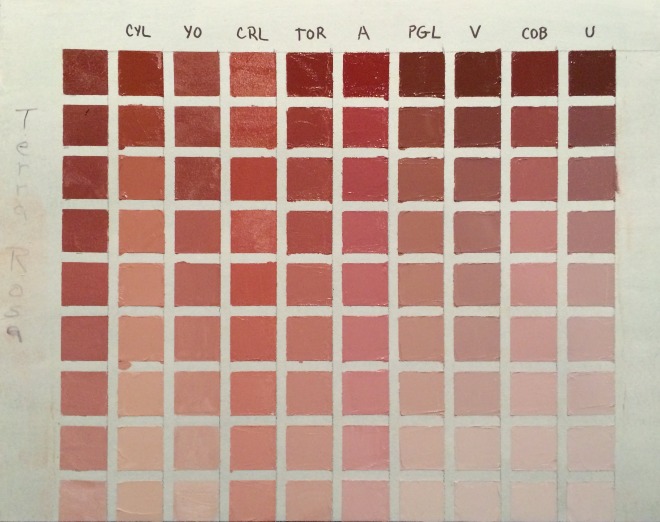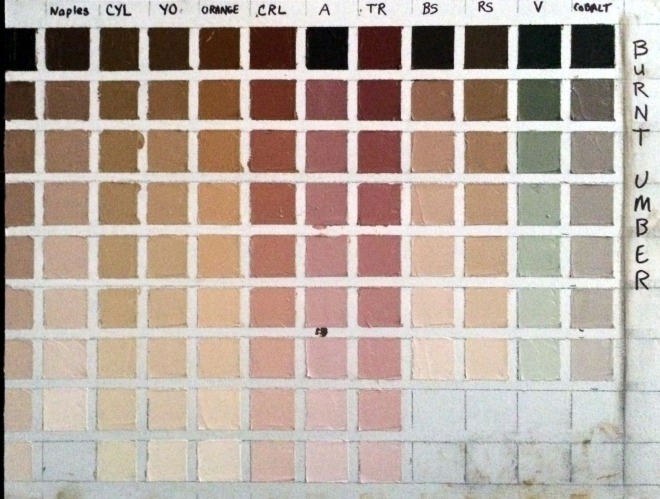Search for Dark Flesh Tones
I'm almost ashamed to post this picture - it's so messy! Yesterday to prevent my hand from cramping, I approached my color chart slowly - only doing a couple of rows at a time and then taking a break. That helped and my hand and wrist survive!
My goal was to find the right flesh tones for an African American girl that I plan to paint. So the color I started with was Burnt Umber.
Here's what I learned:
First I didn't mention in the last post that doing these exercises uses up a LOT of white! I'm using Titanium White.
Another thing I didn't mention is that I'm using the paints I use all the time - in my case they are Rembrandt brand, and it's important to use them because other brands have different tinting strengths and so my charts wouldn't be accurate if I used a different brand of paint on them.
The colors I used on this chart were: Naples Yellow, Cad Yellow Light, Yellow Ochre, Cad Red Light, Alizarin, Terra Rosa, Burnt Sienna, Raw Sienna, Viridian, and Cobalt.
While I was looking for really dark flesh tones, surprisingly I found that Burnt Umber can make some fantastic caucasian skin tones too. Especially the lighter ranges of Burnt Umber mixed with Naples, mixed with Yellow Ochre, and mixed with Burnt Sienna. Even just plain ole burnt umber mixed with white makes a nice neutral caucasian skin tone.
I found that Viridian must have more tinting strength than Burnt Umber because it overpowers it and the mixture turns out green. On the other hand Burnt Sienna seemingly has weak tinting strength.
Burnt Umber mixed with Cobalt gives you a fantastic very slightly greenish gray. I don't know about you, but for me it's very hard to find an easy way to mix a lively gray, so that's very useful to me.
Here's a picture of the girl I'm planning to paint.
From my exercise, I think the color that most closely represents her mid range skin tone is the two darkest versions of burnt umber mixed with raw sienna. The highlights seem to almost go a warm yellowish orange, and so for the highlights I will try the third color down of burnt umber mixed with orange. Then for the darkest dark on the right side of her face, it looks almost dark purple to me ... so there I will use the darkest value of burnt umber mixed with alizarin.
It will be exciting to see how the painting turns out. I've never done a color study "before" painting a portrait, so wish me luck.
My goal was to find the right flesh tones for an African American girl that I plan to paint. So the color I started with was Burnt Umber.
Here's what I learned:
First I didn't mention in the last post that doing these exercises uses up a LOT of white! I'm using Titanium White.
Another thing I didn't mention is that I'm using the paints I use all the time - in my case they are Rembrandt brand, and it's important to use them because other brands have different tinting strengths and so my charts wouldn't be accurate if I used a different brand of paint on them.
The colors I used on this chart were: Naples Yellow, Cad Yellow Light, Yellow Ochre, Cad Red Light, Alizarin, Terra Rosa, Burnt Sienna, Raw Sienna, Viridian, and Cobalt.
While I was looking for really dark flesh tones, surprisingly I found that Burnt Umber can make some fantastic caucasian skin tones too. Especially the lighter ranges of Burnt Umber mixed with Naples, mixed with Yellow Ochre, and mixed with Burnt Sienna. Even just plain ole burnt umber mixed with white makes a nice neutral caucasian skin tone.
I found that Viridian must have more tinting strength than Burnt Umber because it overpowers it and the mixture turns out green. On the other hand Burnt Sienna seemingly has weak tinting strength.
Burnt Umber mixed with Cobalt gives you a fantastic very slightly greenish gray. I don't know about you, but for me it's very hard to find an easy way to mix a lively gray, so that's very useful to me.
Here's a picture of the girl I'm planning to paint.
From my exercise, I think the color that most closely represents her mid range skin tone is the two darkest versions of burnt umber mixed with raw sienna. The highlights seem to almost go a warm yellowish orange, and so for the highlights I will try the third color down of burnt umber mixed with orange. Then for the darkest dark on the right side of her face, it looks almost dark purple to me ... so there I will use the darkest value of burnt umber mixed with alizarin.
It will be exciting to see how the painting turns out. I've never done a color study "before" painting a portrait, so wish me luck.
Terra Rosa Torture!

Every major artist's book recommends the fledgling artist do their color charts. So I thought, "How hard could that be?" And today my mission was to knock out several of them. Boy was I in for a surprise!
First I went to four stores trying to find half inch or quarter inch masking tape. No luck at Lowe's, Walmart, Office Depot, or the craft store. So finally I end up buying green floral tape at the craft store cause it's the only tape I can find that's small enough (quarter inch). I also had trouble finding a T square - finally found one at the craft store.
Then I prepare the canvas. That took forever! Measuring and laying down the tape. But by this time I'm still happy go lucky - moving along - having a good attitude.
I start painting the squares - using my favorite color first - terra rosa. And I start off using a brush. Big mistake! Unless I plan to completely clean my brush each time, the color is just running together. I couldn't wipe off enough paint with a paper towel to make a clean stroke. So I turn to the palette knife. Now, I've never used one before, and I have to say it was absolute torture! As I type this my fingers and wrist are in pain. I'm not usually one to complain but half way through the messy ordeal, I was in agony. I couldn't make a smooth stroke, I couldn't get the darn thing into the square corners. Complete fail!
I realize that I do need to do my color charts. It's a rite of passage, a necessary evil. I realize doing them will help me, and make me grow as an artist. And it's not the color chart or mixing the color that bothers me - it was the darn palette knife!
Ok, enough ranting - off to find the alleve!
Post Notes:
I forgot to include how I made this chart. The first column is the pure color, and the successive blocks down the column show the color mixed with equal parts of white. Then in the remaining columns, the first block is the pure color (in this case terra rose) mixed with an equal part of another color. I am using Cadmium Yellow Light, Yellow Ochre, Cadmium Red Light, Transparent Oxide Red, Alizarin, Permanent Green Light, Viridian, Cobalt, and Ultramarine. Then down the columns, in the successive blocks each new color is mixed with an equal part of white. Hope that explains how I made it.
Things I learned from this exercise:
It's extremely messy!
You can't use a brush - this is really best suited for the palette knife. And that makes me wonder about my alla prima sessions - I probably need to use more brushes or clean them more often to get clean color.
How the addition of white changes the mixtures.
How the colors appear most vivid in the mid range.
Looking at the chart, the flesh tones that appeal to me the most are Terra Rosa mixed with Cad Yellow Light and Terra Rosa mixed with Permanent Green Light. They would make excellent caucasian flesh tones. I'm surprised at how the mixture turned out with Cad Yellow Light - it's not orange at all so that makes me think that Terra Rosa must have some blue or green in it to begin with.
Terra Rosa mixed with Cad Red Light would make good warm shadows for the ears, cheeks, and mouth, while Terra Rosa mixed with Alizarin would make great cool reds in those same areas.
Terra Rosa mixed with Ultramarine or mixed with Viridian makes really nice cool shadows for use under the chin in the neck area or receding planes on the forehead.
As I mentioned Terra Rosa is one of my favorite colors - but it's a recent addition to my palette. I have googled it but can't find the mixture to know how Terra Rosa is made. If anyone knows the color recipe please share with me!



